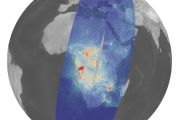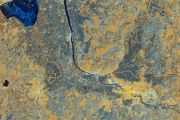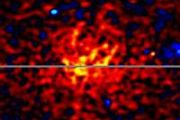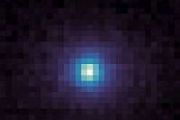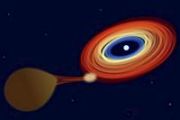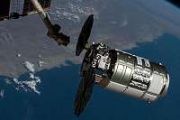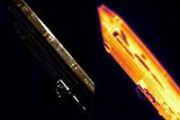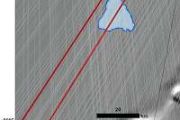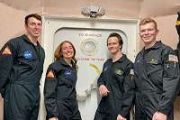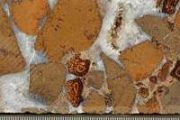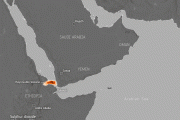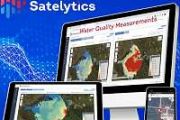
Copernical Team
Scientists find evidence the early solar system harbored a gap between its inner and outer regions
 In the early solar system, a "protoplanetary disk" of dust and gas rotated around the sun and eventually coalesced into the planets we know today.
A new analysis of ancient meteorites by scientists at MIT and elsewhere suggests that a mysterious gap existed within this disk around 4.567 billion years ago, near the location where the asteroid belt resides today.
The team's results, ap
In the early solar system, a "protoplanetary disk" of dust and gas rotated around the sun and eventually coalesced into the planets we know today.
A new analysis of ancient meteorites by scientists at MIT and elsewhere suggests that a mysterious gap existed within this disk around 4.567 billion years ago, near the location where the asteroid belt resides today.
The team's results, ap San Andreas Fault-like tectonics discovered on Saturn moon Titan
 Strike-slip faulting, the type of motion common to California's well-known San Andreas Fault, was reported recently to possibly occur on Titan, Saturn's largest moon. New research, led by planetary scientists from the University of Hawai?i at Manoa School of Ocean and Earth Science and Technology (SOEST), suggests this tectonic motion may be active on Titan, deforming the icy surface.
On m
Strike-slip faulting, the type of motion common to California's well-known San Andreas Fault, was reported recently to possibly occur on Titan, Saturn's largest moon. New research, led by planetary scientists from the University of Hawai?i at Manoa School of Ocean and Earth Science and Technology (SOEST), suggests this tectonic motion may be active on Titan, deforming the icy surface.
On m Climate model shows that Venus could never have had oceans
 Whether Venus, one of the Solar System's four terrestrial planets, ever had oceans remains an unsolved puzzle. Although an American study hypothesized that it did, this is now challenged in a paper published on October 14, 2021 in Nature, involving in particular scientists from the CNRS and University of Versailles-Saint Quentin-en-Yvelines1 (UVSQ).
Using a state-of-the-art climate model,
Whether Venus, one of the Solar System's four terrestrial planets, ever had oceans remains an unsolved puzzle. Although an American study hypothesized that it did, this is now challenged in a paper published on October 14, 2021 in Nature, involving in particular scientists from the CNRS and University of Versailles-Saint Quentin-en-Yvelines1 (UVSQ).
Using a state-of-the-art climate model, The unusual magnetic fields of Uranus and Neptune
 Not all ice is the same. The solid form of water comes in more than a dozen different - sometimes more, sometimes less crystalline - structures, depending on the conditions of pressure and temperature in the environment. Superionic ice is a special crystalline form, half solid, half liquid - and electrically conductive. Its existence has been predicted on the basis of various models and has alre
Not all ice is the same. The solid form of water comes in more than a dozen different - sometimes more, sometimes less crystalline - structures, depending on the conditions of pressure and temperature in the environment. Superionic ice is a special crystalline form, half solid, half liquid - and electrically conductive. Its existence has been predicted on the basis of various models and has alre Mixing system prototype for future greenhouses on the Moon
 Developing greenhouse systems is of great importance and requires Bio-regenerative Life Support Systems (BLSS) to ensure that the lives of crew members are sustained. Two new prototypes of a nutrient mixing system for future Moon and Mars greenhouse modules have now been completed and installed following a successful design and development phase between Priva and the German Aerospace Center (Deu
Developing greenhouse systems is of great importance and requires Bio-regenerative Life Support Systems (BLSS) to ensure that the lives of crew members are sustained. Two new prototypes of a nutrient mixing system for future Moon and Mars greenhouse modules have now been completed and installed following a successful design and development phase between Priva and the German Aerospace Center (Deu China says recent test was spacecraft not missile
 China on Monday denied a report it had recently launched a hypersonic missile, saying it tested a spacecraft to trial reusable technologies.
The Financial Times reported Saturday that Beijing had launched a nuclear-capable missile in August that circled the Earth at low orbit before narrowly missing its target.
FT sources said the hypersonic missile was carried by a Long March rocket and
China on Monday denied a report it had recently launched a hypersonic missile, saying it tested a spacecraft to trial reusable technologies.
The Financial Times reported Saturday that Beijing had launched a nuclear-capable missile in August that circled the Earth at low orbit before narrowly missing its target.
FT sources said the hypersonic missile was carried by a Long March rocket and Successful static firing test with DLR involvement
 On 1 October 2021, an S50 solid-propellant rocket motor, which will form the first two stages of the new VLM-1 launch vehicle, successfully completed a static firing test in the operational area of Usina Coronel Abner (UCA), in Sao Jose dos Campos, Sao Paulo state, Brazil. The test was conducted by an engineering team from the Aeronautics and Space Institute, which is headquartered in Sao Jose d
On 1 October 2021, an S50 solid-propellant rocket motor, which will form the first two stages of the new VLM-1 launch vehicle, successfully completed a static firing test in the operational area of Usina Coronel Abner (UCA), in Sao Jose dos Campos, Sao Paulo state, Brazil. The test was conducted by an engineering team from the Aeronautics and Space Institute, which is headquartered in Sao Jose d Next Generation Interceptor Program Achieves Critical System Requirements Review
 Lockheed Martin has announced that the U.S. Missile Defense Agency (MDA) approved its Next Generation Interceptor (NGI) program's System Requirements Review (SRR) - six months after the initial development and demonstration contract award.
The MDA's NGI program is designed to protect the United States from complex, rogue threat, ballistic missile attacks. The interceptor is an end-to-end d
Lockheed Martin has announced that the U.S. Missile Defense Agency (MDA) approved its Next Generation Interceptor (NGI) program's System Requirements Review (SRR) - six months after the initial development and demonstration contract award.
The MDA's NGI program is designed to protect the United States from complex, rogue threat, ballistic missile attacks. The interceptor is an end-to-end d Chinese astronaut bridges gender gap
 China's landmark six-month journey in space has left many curious about the differences between male and female astronauts.
Wang Yaping, a 41-year-old female astronaut from Shandong province in East China, became the first Chinese woman to enter China's space station after the trio settled inside the Tianhe core module last week.
"Astronauts need to meet high physical and emotional s
China's landmark six-month journey in space has left many curious about the differences between male and female astronauts.
Wang Yaping, a 41-year-old female astronaut from Shandong province in East China, became the first Chinese woman to enter China's space station after the trio settled inside the Tianhe core module last week.
"Astronauts need to meet high physical and emotional s Test conducted to verify spacecraft technology, FM says
 The Chinese space test that drew great attention was made to verify reusable spacecraft technologies, not to test a nuclear-capable hypersonic missile, as some foreign media claimed, the Foreign Ministry said on Monday.
Responding to questions about the test, ministry spokesman Zhao Lijian said at a daily briefing at the ministry in Beijing that he was told it was a regular test flight by
The Chinese space test that drew great attention was made to verify reusable spacecraft technologies, not to test a nuclear-capable hypersonic missile, as some foreign media claimed, the Foreign Ministry said on Monday.
Responding to questions about the test, ministry spokesman Zhao Lijian said at a daily briefing at the ministry in Beijing that he was told it was a regular test flight by 






